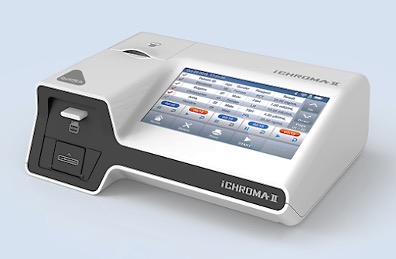Biomarkers Evaluated for Severity of Diabetic Kidney Disease
By LabMedica International staff writers
Posted on 24 Aug 2020
Type 2 diabetic mellitus (T2DM) is a chronic metabolic disorder with multiple complications, including diabetic retinopathy, diabetic neuropathy, diabetic kidney disease (DKD) as well as cardiovascular diseases. T2DM is related to an exacerbated systematic inflammation. Posted on 24 Aug 2020
Among all plasma inflammatory biomarkers, erythrocyte sedimentation rate (ESR) and high-sensitivity C-reactive protein (hsCRP) are the mostly commonly used laboratory tests for identifying systematic inflammation. Both ESR and hsCRP are important markers in various inflammation-related diseases.

Image: iCHROMA is an automatic or semiautomatic in-vitro diagnostic device that measures via cartridges the concentration of analytes, contained in blood, urine, or other samples, in quantitative or semi-quantitative ways (Photo courtesy of Boditech Med Inc).
A team of endocrinologists at Huashan Hospital (Shanghai, China) conducted a cross-sectional study in 1,210 patients with T2DM, among whom 265 had DKD. The severity of DKD was assessed by estimated-glomerular filtration rate (eGFR) and urinary albumin creatinine ratio (ACR). The relationship between ESR, hsCRP and DKD was analyzed by multivariate logistic analysis. The relationship between ESR and eGFR, ESR or ACR was analyzed by multivariate linear regression.
Fasting blood sample was collected to measure fasting plasma glucose (FBG), glycated hemoglobin (HbA1c), hsCRP, serum albumin (ALB), globulin (GLB), total cholesterol (TC), triglyceride (TG), high-density lipoprotein cholesterol (HDL) and low-density lipoprotein cholesterol (LDL), serum creatinine (SCr), and ESR. ESR was measured using ESR-30 fully automatic dynamic analyzer (Xunda Medical Instrument Co., Ltd., Shanghai, China). FBG, TC, TG, HDL, LDL, ALB, total protein, SCr was quantified by Beckman AU5800 (Beckman Coulter Inc., Brea, CA, USA). HsCRP was detected by iCHROMA reader (Boditech Med Inc, Chungcheon-si, South Korea).
The scientists reported that ESR (23.0 mm/h [12.0 ~ 41.5] versus 12.0 mm/h [7.0 ~ 22.0], and hsCRP (3.60 mg/L [2.20 ~ 7.65] versus 2.90 mg/L [1.80 ~ 5.60],) values were significantly higher in patients with DKD than those without. Patients with higher ESR or hsCRP had lower eGFR and higher urinary albumin creatinine ratio (ACR). After adjusted for gender, age, hemoglobin, plasma proteins, HbA1c, lipid profiles, and the usage of renin-angiotensin system inhibitors, ESR but not hsCRP was independently associated with the rate and severity of DKD in patients with T2DM.
The authors concluded that their study underlined the role of inflammation in DKD. The study found that, both ESR and hsCRP correlated with DKD in T2DM, of which ESR was an independent risk factor for DKD and positively associated with severity of DKD. The study was published on July 13, 2020 in the journal BMC Endocrine Disorders




 assay.jpg)








